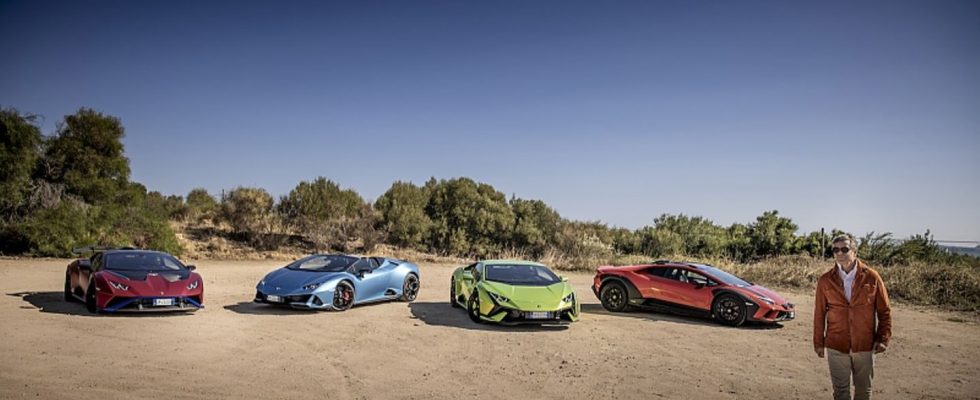Fascination: Lamborghini says goodbye to the magnificent ten-cylinder
Goodbye V10
Lamborghini Huracan Family 2023
© press-inform – the press office
It dominated the Lamborghini portfolio for around 15 years and was able to compete against the impressive twelve-cylinder engines from Murcielago and Aventador. But next year the glory of the ten-cylinder engine that so charismatically inspired the Gallardo and Huracan will be over. Time to look back.
That’s it with the ten-cylinder. Next year, when the Huracan successor switches to a V8 turbo engine with electric assistance, the charismatic 5.2-liter naturally aspirated engine will disappear from the northern Italian company’s powerful portfolio. Once again we want to celebrate the V10 engine in its very different sports car versions. In front of me are the four musketeers, which are worth seeing. A blue Evo Spyder that invites you to lower the convertible roof and enjoy the unfiltered Mediterranean breeze on the Costa Smeralda. Driven by the 640 hp V10 power plant, discreetly supported by additional features such as rear axle steering and torque vectoring. Parked next to it is the aggressive STO in the bordeaux-colored livery of FC Barcelona, a road-legal racing car that offers the same performance as the Evo, but has significantly less to worry about and, last but not least, wants to impress with its aerodynamics. Power is transmitted solely via the rear axle, while high-performance brakes ensure a happy ending. If you like something a little tamer, you should definitely opt for the still young Tecnica version of the Huracan, which is equally exciting on the road and on the racetrack. Even wilder because it is sharper, the Sterrato in the bold color Arancio Xanto, which shows that you can have fun with a Lamborghini even off the beaten track.
All four Huracans offer notable differences in their driving modes, which can be selected using a button at the bottom of the steering wheel. Evo and Tecnica have Strada, Sport and Corsa modes for the most intense moments, ideally on the racetrack. With the STO you can choose between the STO, Trofeo and Pioggia – Italian for rain – modes, which better control the torque on wet asphalt. Finally, the Sterrato adds a Rally mode to the first two modes of Evo and Tecnica, giving the stability control and braking systems a longer leash to have fun like a rally pilot.
Visually, the Huracan STO and Sterrato stand out most noticeably from the rest of the Lambo gang with their aerodynamic subtleties. On the STO, these are spread across carbon fiber bodywork, magnesium wheels and a menacing Akrapovic exhaust system. What stands out on the Sterrato are the aluminum underbody protection, the powerful side skirts, as well as the rear diffuser with its rustic flair and flared wheel arches. The interior of each of these four Huracans has a true jet ambience, which is skilfully showcased by finishes in black Alcantara and carbon, hexagonal shapes, contoured sports seats and the central digital screen. After folding up the dramatic and almost sensual red metal frame, I sit behind the wheel of the Tecnica and am ready to press the start button. The anticipation is comparable to that experienced by Indiana Jones when he was about to put his hands into the Holy Grail. The engine starts and the sound is breathtaking from the first second. The shrill roar of the V10 explodes and suddenly all senses are wide awake. The rear-wheel steering makes parking and maneuvering in the city easy, and when driving, the front of the car automatically lowers when the 75 km/h mark whizzes past.
Want a little more adrenaline? Once you get out of the inside start, the traffic decreases and the driving pleasure increases. When Sport mode is switched on, the decibels and drama increase, while the engine and transmission mapping can now show what they are capable of. Disadvantage: the unevenness in the road noticeably finds its way into the interior of the roaring two-seater as the pace increases, while the steering precision and braking remain in stoic calm as I try to aim for the curves more and more accurately. Emotions are running even higher in the STO. The weight distribution favors the rear and the monstrous rear wing, adjustable in three positions, ensures that the concentrated 640 hp are delicately banished to the ground as the tachometer lets the naturally aspirated engine sound in upper octaves. In its highest position, the tail unit can generate 53 percent more downforce and push the car downwards with a force of 420 kilograms at a speed of 280 km/h. In the lower positions, 324 kilograms of downforce literally stick the Super Trofeo Omologata to the ground.
The final drive in the rustic Sterrato is completely different – a car that no one has asked for, but everyone seems to want to own. Apart from its similarly positioned corporate sibling, the Porsche 911 Rallye, it is unlike anything else on the road. That alone makes the high-profile car with a price of around 300,000 euros so desirable for fans. It shouldn’t bother anyone that there are a few fewer horses tramping behind the passenger cell in the long-legged car and that it stops at 260 km / h, while its brothers go well over 300 km / h. But once again, it’s not least the sound that makes the music and, thanks to the spectacular ten-cylinder engine, it’s simply captivating, even in the Sterrato. Goodbye Huracan, goodbye V10. We will miss you both very much.

